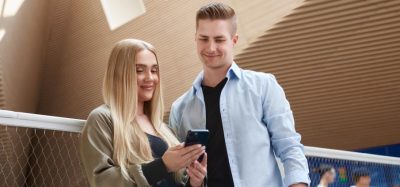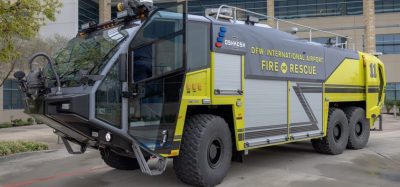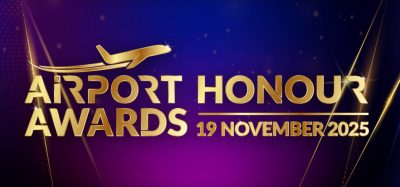Winter Operations: Keeping snowfall under control at Copenhagen
- Like
- Digg
- Del
- Tumblr
- VKontakte
- Buffer
- Love This
- Odnoklassniki
- Meneame
- Blogger
- Amazon
- Yahoo Mail
- Gmail
- AOL
- Newsvine
- HackerNews
- Evernote
- MySpace
- Mail.ru
- Viadeo
- Line
- Comments
- Yummly
- SMS
- Viber
- Telegram
- Subscribe
- Skype
- Facebook Messenger
- Kakao
- LiveJournal
- Yammer
- Edgar
- Fintel
- Mix
- Instapaper
- Copy Link
Posted: 1 June 2019 | Lars Aspelund Faurschou | Head of Airside Support | Copenhagen Airports A/S | No comments yet
Lars Aspelund Faurschou, Head of Airside Support at Copenhagen Airports A/S, explains how an all departments method is the best way to tackle to frequent and sometimes sudden winter weather that impacts Copenhagen Airport.
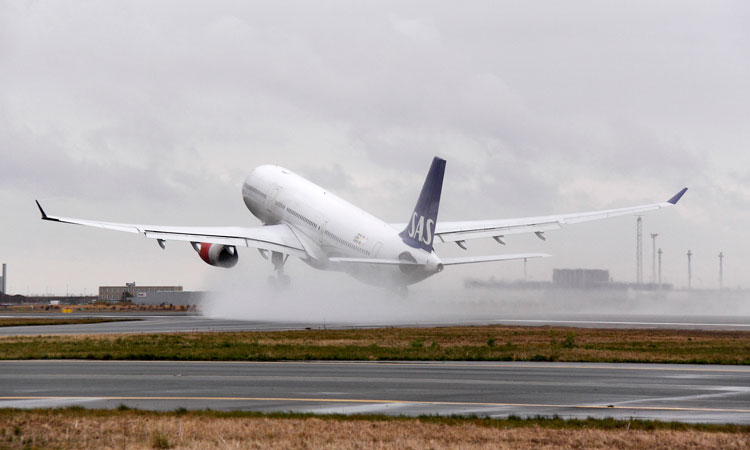

At Copenhagen Airport (CPH) we have a well-trained snow alert crew, who can be organise swiftly, depending on the intensity of the snowfall. The snow alert crew consists of CPH employees, who on a daily basis perform other duties on and around the airports premises, and therefore are familiar with the airport. The areas in need of snow clearing is complex and includes the following:
- Runway (RWY): 631,000m2
- Taxiways (TWY): 1,200,000m2
- Apron: 550,000m2
- Landside: 400,000m2
World Class team – The snow alert crew at CPH
To enable the best possible snow clearing at CPH, all the involved employees are trained in snow handling annually. This ensures that the entire snow alert crew is well-informed and prepared prior to potential snowfall. During the period 15th of November to 15th of April the snow alert crew is active, meaning that all 294 trained employees may be called on duty in turns. That is, 55 employees on duty per day during a four-day period.
The employees expected for snow clearing are assigned an on-call-service at home, and can step in quickly in case of sudden snowfall. The snow alert crew is a diverse group including employees from the following departments:
- 90 maintenance employees (Field Service)
- Eight team leaders
- Five on duty operational managers
- 14 auto mechanics and four foremen
- 177 supporters (fire & rescue, bus service & marshals, baggage service and baggage hall)*
*Employees who are rotational off duty and can work overtime.
Depending on the intensity of the snowfall, it is possible to determine the number of employees needed. However, it is estimated that approximately 55 employees are needed for a blizzard, and 30 for normal snowfall. Therefore, there are resources for four to five days of complete snow clearing at CPH; however this number is continuously updated depending on the intensity of the snowfall. We are aware of the need to use our resources in the most optimal manner; hence they are allocated depending on the actual need, in case snow fall lasts for several days.
Training of the snow alert crew
Hard work is needed is to establish a robust snow alert crew. At CPH the driving forces are commitment and will, and a motivation to succeed. It is the motive for all, because everybody is aware of the importance of an airport clear of ice and snow. At CPH there is an annual snow clearing brush-up course in the period September to November. Simultaneously there are brush-up courses for external business partners such as air traffic controllers; Naviair, and handlers; Aviator, Menzies, SAS Ground Handling (SGH) and Copenhagen Flight Service (CFS). The courses are conduct by CPH and it is employees from Field Service, who put it into practice, since they have comprehensive experience with snow clearing.
Cross-functional collaboration gives on-time best performance
Since snow clearing is a complex matter at CPH, collaboration across departments and business partners is a key issue. At CPH we have decided to focus on collaboration and inclusion of all parties in the entire process; that is from preparation to execution, which entails that everyone involved has practical knowledge regarding the process. Therefore we have invited Air Traffic Control to come observe snow clearing in practice – this has given them larger insight, and they have likewise invited the snow alert crew to come visit the air traffic control tower. These initiatives have led to larger appreciation of each other and the work being carried out. Moreover there is an annual handler meeting at the trade union 3F, which all involved parties attend; Aviator, Menzies, SGH and CFS. Representatives from fuelling (BLK) and aircraft cleaning (Sodexo) attend. There is an annual planning meeting in September regarding the plan ‘The Local Snow Plan’, where all parties (Naviair, Airlines and handlers) are represented, as well as CPH. At this meeting new possible focus areas for the upcoming snow season are addressed.
Snow prediction
Snow clearing management requires the best possible predictions of the weather conditions. At CPH we have our own command centre at Field Service (MAR), which is manned 24-hours a day; the staff here has several years of experience with the systems and with analysing its output, hence they function as CPH’s own weather forecasters. To strengthen the weather predictions CPH has two external weather forecast institutes affiliated; the Danish Meteorological Institute (DMI) and Metro Group. Nine employees have access to the ice-warning system, which is a system consisting of 27 sensors located in the ground all over the airport, measuring type of precipitation, and the temperature of the roads. This system gives an indication of the weather conditions, and in the long term how resources are best allocated, depending on the intensity of the snowfall.
Weather challenges
Despite suitable systems for predicting the weather, there may be challenges in regard to weather predictions after all. Since CPH is located near the Baltic Sea, a specific snow phenomenon may develop suddenly: When a low-pressure area located over the sea, consisting of clouds, precipitation and strong winds, moves in over land, it results in heavy snow fall over a short period of time, e.g. 20 cm of snow in a few hours. Moreover, white frost may be a challenge, since the moist present in the surface can form ice, which results in slippery ground surfaces. All runway lights on the manoeuvring area are LED lighting and do therefore not emit heat, meaning ice and snow do not melt as easily near runway lights as it used to do. Thus we need to be even more aware of white frost, than we were in the past, to enable management of this challenge.
Execution of snow clearing
Snow clearing is a complex matter and demands close collaboration across fields. Furthermore, snow fall varies year by year. Below is a presentation of the previous nine years snow clearing:
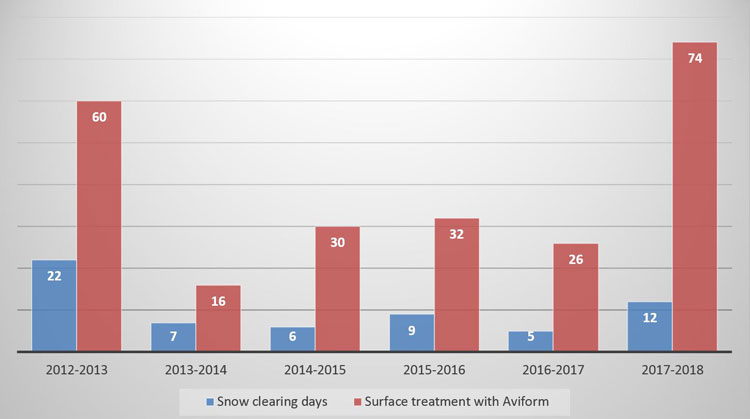

Some year’s snow clearing has been quite demanding whereas others have given very few snow clearing days. it is therefore vital that all equipment and employees are ready at all times. Aviform is a surface treatment we apply on surfaces to ensure that ice and stuck snow can melt.
During snow clearing the apron is divided into six zones (below); this enables coordination depending on where the need for clearing is most urgent, equipment, and amount and type of snowfall. This zoning at Apron is vital regarding training of employees. They are familiarised with the tasks associated with each zone and know exactly what their job is in the specific zone they are assigned. Both employees and equipment are assigned a specific zone, which entails that no time is wasted on long-distance logistics if an urgent need emerges.
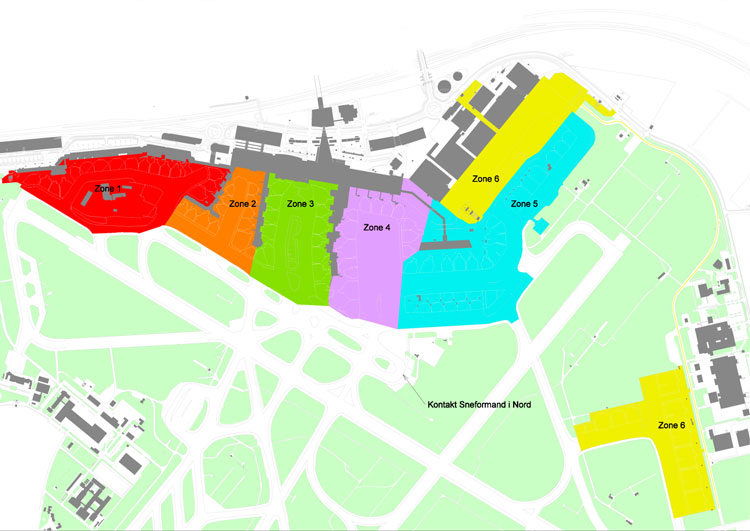

Climate change
In Denmark, climate change manifests itself as more days with strong wind, rain and snow. Therefore, at CPH we have trained our snow alert crew into both heavy precipitation and snowfall. In general, we experience shorter periods with snow; however, when it snows – it is short periods of intense snow fall. This tendency has created a need for a better and more effective snow alert crew. We have invested in more employees and tractors, especially smaller tractors, which enable us to target snow clearing more precisely in each zone. More supporters have been allocated internally in CPH, to visualise towards our customers; handlers and pilots, that we are present in high numbers and that taxiways and stands are cleared swiftly and effectively.
Snow clearing on manoeuvring area
Six years ago we invested massively in sweeping machines, enabling clearing of runways at once, and thereby reducing the time consumption from 35 minutes to 12 minutes. This has resulted in a significant reduction of delayed flights, due to an overall ease of pressure and reduction of the wait for the deicing areas. Therefore, as much as 60 per cent more aircrafts per hour take off during heavy snowfall.
Clearance of the runways is carried out using 15 sweeper machines of the brand Øvreaasen and two snow blowers of the brand Oshkosh. Simultaneously a Sarsys friction tester is launched on to the runways to measure friction. Moreover, two tractors ensure clearance of stop bars.
Since the arrival of the A380 it is still possible to clear the runway, despite it is eight metres wider. Two additional sweeper machines have been added to a total of 14, enabling clearance at once.
For ice clearing we have two runway de-icing vehicles of the brand Damman, which can apply Aviform in a width of 45 metres.
Snow clearing at apron
The apron area is divided into zones, and depending on the intensity of the snowfall, there will be three to five tractors/employees in each zone, who know their exact assignment.
In total 30 tractors can be present on apron, participating in snow clearing. Moreover, there is a sweeper team consisting of three to four sweeper machines and two wheel loaders. During the execution of snow clearing at apron, there is close collaboration with Apron Tower to ensure that the process proceeds as effective as possible.
Snow clearing landside
All parking areas are of course cleared as well, which is a result of ongoing coordination among the snow clearing employees, who are informed of needs of snow cleaning on landside, that is parking areas among others.
Biography
Lars Aspelund Faurschou is Head of Airside Support at Copenhagen Airports. He has been part of Copenhagen Airport for 24 years, beginning as a blue-collar worker back in 1995 and working his way up to Team Leader and Field Service from 2002-2011, where he then became Manager of Field Service. In 2013, Lars managed both Field Service and the Auto Repair Shop, thus creating the first move towards ‘Airside Support’. In 2017, this department reached its current shape, which now consists of Field Service, Auto Repair Shop, Landside and Airside Busses, Aircraft Marshalls and Trolley Services. Lars is now responsible for 300 employees. He has been working consistently with winter conditions, snow alert crews and snow clearing since 2002.
Issue
Related topics
Airside operations, Sustainability, Terminal operations, Winter operations
Related airports
Related organisations
Aviator, Copenhagen Flight Service (CFS), Danish Meteorological Institute (DMI), Menzies, Naviair, SAS Ground Handling (SGH), Sodexo




